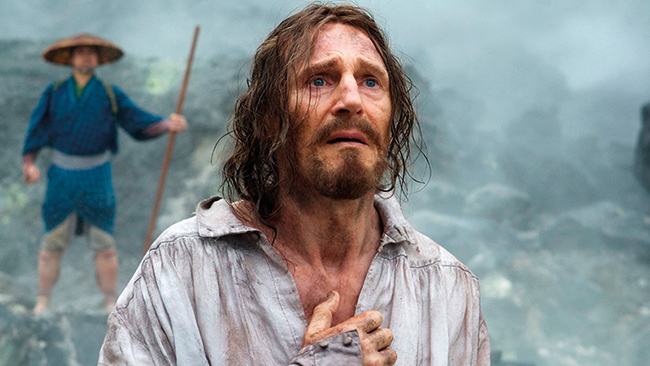Review: Silence
March 31, 2017

Silence, directed by Martin Scorsese, is based on the award-winning book by Japanese author Shūsaku Endō. It opens some 10 years after Christianity has been outlawed in 17th century feudal Japan.
Roman Catholic missionaries have been tortured to death, and local converts forced to deny their faith or face the same fate. However, church officials have received even more disturbing news: mission stalwart Father Ferreira (Liam Neeson) has denied his faith and is assisting the Japanese overlords in rooting out the remnants of Christianity. Andrew Garfield stars as Rodrigues, the young Jesuit priest sent to investigate, who is accompanied by Father Garrpe, played by Adam Driver. Their mission is to give comfort to any surviving Christians they find. The Japan they arrive in is a terror-state for persecuted believers.
The Japanese Christians who Rodrigues and Garrpe discover are mostly fervent in their belief and thankful to God for sending them. However, every evidence of the priests’ presence must be carefully hidden. Suspicions circle around their Japanese guide, Kichijiro (Yôsuke Kubozuka), who is ever helpful, but has denied his faith once before in order to save himself. When the Christian community is betrayed, Rodrigues and Garrpe witness how the local believers hold on to their faith, even under torture.
Yet a question—and it is somewhat universal—constantly arises: Where is God in all of this? Rodrigues struggles to understand his Saviour’s silence in the face of suffering. Dilemmas arise: Can a person be silent about their faith yet stay faithful? Is God really silent, or is His silence an answer? And does heaven still hold a place for the hapless believer who denies his Lord? Silence is among the most provocative Christian films to be produced by a non-Christian Hollywood. Viewers will not be able to “sit back and enjoy it” without confronting these questions. Endō’s work was dominated by his Christian faith. In Silence he sets about introducing his readers to a God who does not move to end suffering but chooses instead to suffer alongside believers in the form of His Son. The result is emotionally moving and morally challenging, and its conclusion unsettling.
Take, for example, the pressure to remain silent in the face of persecution. If the Japanese faithful are prepared to trample on the fumie (crudely carved images of Christ), they will be set free. Their tormentors tell them it is merely a formality, but their hearts hesitate to partipate. Rodrigues and Garrpe are soon at loggerheads as to what to tell the faithful. Rodrigues encourages them to “Trample!” and, in at least one sense, he is right—images are nothing more than emblems—and if it means saving a life, then sensibilities should be set aside. However, Garrpe realises the fumie represent much more.
Modern audiences will be tempted to side with Rodrigues in the face of the pathetic suffering. Yet the Bible is clear on the value of public confession, even in the face of persecution.
Is God really silent in the face of suffering? Again, secular viewers might conclude Christianity is a faith hardly worth valuing if it must end the lives of its supporters to prove that value. Yet the very Jesus the apostle Paul wrote about is God’s answer to the accusation that He sits idly by in the face of persecution. Rodrigues comes to understand that Jesus not only suffered on his behalf but is present with him even in his doubt: “When you suffer, I suffer with you . . .” be it in ancient Japan, the sneering West or violent Middle East.
At its end, Silence does seem to align more with modern thought. Yet Jesus makes it clear to His disciples that He is the only way to God, and no-one can expect to deny Him and still reach the Father.
Which leads me to wonder what God might say to the wretched Kichijiro? While others follow Jesus to suffering and the grave, Kichijiro complains that he is weak and runs from persecution. He is easily the film’s most loathsome character. Yet he also becomes a living proof of the words the young Rodrigues speaks to Garrpe much earlier: “Christ did not die for the good and beautiful. It is easy enough to die for the good and beautiful; the hard thing is to die for the miserable and corrupt.”
Jesus may disown those who ultimately disown Him, but Kichijiro’s role in Silence reminds me strongly of a trustworthy saying that should give hope to all who struggle to follow Christ:
“If we are faithless, he remains faithful, for he cannot disown himself” (2 Timothy 2:13).










